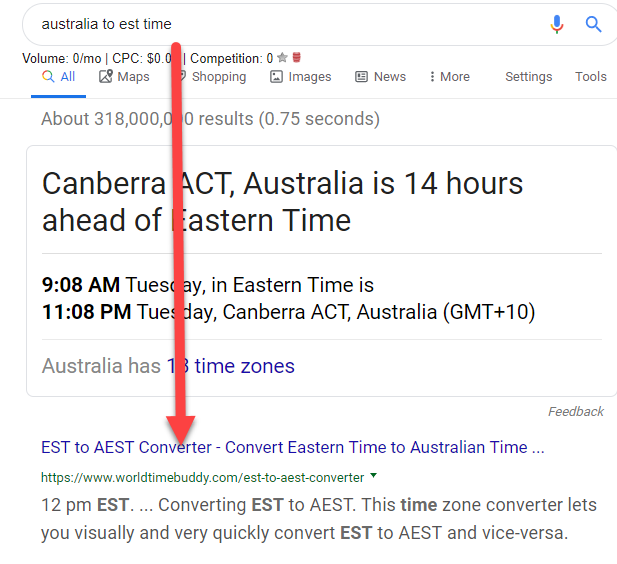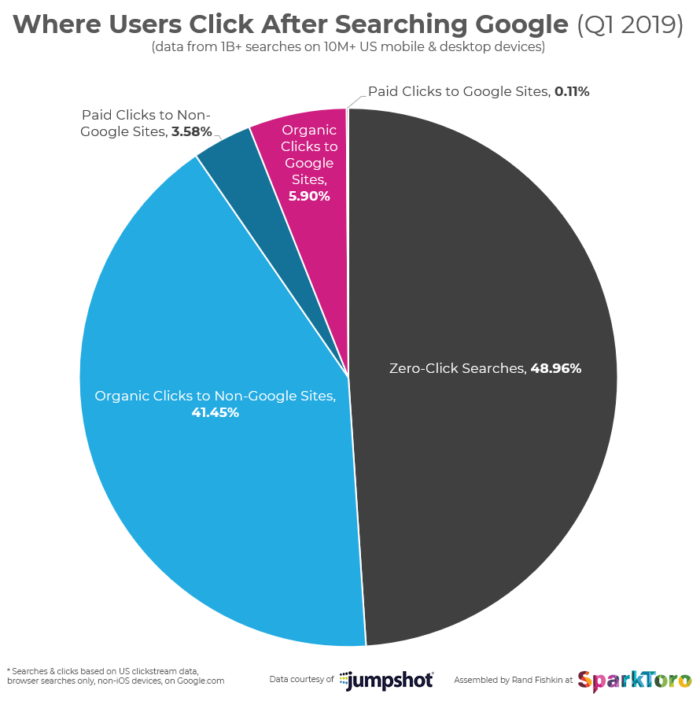For better or worse, search engine optimization has never been a slow-moving field. For brands and organizations desiring to stay visible in search engines, keeping up with Search and Google trends and changes can seem like a part-time job all by itself.
If you’ve been a busy marketer, you may have missed one very important update that SEOs have been talking about over the last few months: the rise in zero-click searches.
What Are Zero-Click Searches?
“Zero-click searches,” also referred to as “no click search results,” is a term that describes when Google answers the query directly at the top of the search results. This type of search concludes in zero clicks being driven to an actual website. And why would a click be necessary if a user gets what they need? Case in point:

If I wanted to know the time change from Atlanta to Australia, I no longer have to go to a time converting website. I do my search, get the answer I need, and leave Google happy to shave off a few seconds of precious time. This is great for me as a searcher, but not so great for marketers. And certainly not great for this website which is the first organic result, but is probably losing out on clicks back to their site big time:

Here’s an important distinction to note – zero-click searches is not the same thing as Featured Snippets, or Position 0, which is another topic I covered comprehensively in past posts (“Part 1: What is Position 0” and “Part 2: How to Rank at Position 0“). The difference is, Featured Snippets produces a snippet with a link to the website result, whereas no-click searches omit any link or attribution.
Zero-click searches are even more prevalent on mobile. According to Sparktoro.com, for every 100 Google searches on mobile, there were:
- 38.5 clicks to an organic result
- 3.4 clicks on a paid result
- 61.5 no-click, or zero clicks, searches
Rand Fishkin (SEO godfather, formerly of Moz, and current founder of SparkToro), partnered with Jumpshot, a company that specializes in clickstream monitoring (a fancy term for software that records pages visited in browser sessions). They recently analyzed Google search data and shared some fascinating statistics. One of the stats that has grabbed attention was this: in Q1 2019, Google solved 48.96% of searches without a click. That means half of the searches on Google ended without a single click going to a website.
Check out their chart showing a visual of what happens after searchers performed a Google search from Q1:

When you couple that with the fact that the first spot on Google gets 30% CTR and the lowest organic positions on page 1 get a 2% CTR, you can see why marketers are concerned. (Data from research click-through rate studies.)
Why Is Google Shifting to Answering Queries Directly?
Many people mistakenly think Google is a tech monopoly. But when it comes to consumer attention, ad clicks, and platform usage, they have stiff competition.
The thing is, Google is fighting to keep people on its platform. They’re competing against Amazon, which is a popular search engine all on its own. Personally, I go straight to Amazon and conduct many searches when I’m looking for products, makeup, books, toys, and even clothes now. Apple is a huge competitor for Google. On mobile, Google is dealing with consumers bypassing Google usage completely and instead going right into their apps. According to ComScore, mobile users spend 87% of their time in apps, versus just 13% on the web. For example, when I’m looking for recipes, holiday activities for the kids, or decorating ideas, or specific exercises, I go straight to Pinterest.
In the end, Google has to evolve to keep up with the demanding nature of searchers like you and I. Google’s job is to satisfy users to keep them coming back. (It’s also why Google stresses the importance of fast website site speed and performance). By presenting content and answers directly, this ultimately saves searchers time not having to click to websites, which increases satisfaction.
Fewer People Are Clicking Through to Websites
I’ve been practicing SEO for 10 years now. Two observations I’ve made over the years that fall in line with this data are the following:
- Ranking on Page 1 is not the windfall it used to be; I used to be able to rank a website on Page 1, and that automatically was equated with tons of clicks and website traffic. Today, there is so much more competing with attention on Page 1, a click is much harder to come by. It’s going to take many keywords and diverse content formats ranking well and being prominently visible to really drive traffic. Of course, there are a few exceptions to that rule, but for the vast majority of websites out there, diversity is your friend, and a handful of target keywords isn’t going to cut it. Having a Page 1 result no longer brings the traffic windfall it used to.
- Generating conversions from SEO takes longer than it used to; in all industries, consumers are searching earlier, and more frequently. This means they look at more options, and ensure they’re doing their due diligence before they’re ever ready to buy. As much as we want our users to fall in love with our site and fall down the rabbit hole consuming all of our great content, that’s just not the way it’s done anymore. Particularly for complex sales; you have to put smaller offers in front of an audience that to build trust before they ever make a larger purchase. The higher you go up the funnel to capture school leaders and Educators when they’re in their research phase, the more you’ll have to have a plan to get your content everywhere and bring Educators back multiple times before they become a valid lead.
How Educators and Teachers Use Google
While this news is somewhat depressing, there is a light at the end of the tunnel. We live in a research-obsessed culture. Years ago, Google estimated that people search over 3.5 billion searches daily. That number continues to grow. And in the SparkToro article referenced above, they found that in Q1 of 2019, SEO is far from dead; there are 11.6 clicks to organic results for every 1 paid Google result. And let’s face it: Google still sends way more traffic to websites than Facebook ever will.
Educators in particular, search heavily. Search patterns indicate two things we Education marketers must know:
- More than the average consumer, educators do their due diligence to make sure they’re viewing credible, trustworthy sources of information. Our content has to be on point. Generic, blah copy won’t cut it.
- Just because this is an educated, sophisticated market, it doesn’t mean your copy and content should be complex, overly wordy, or stuffy. This time-starved audience needs brevity and content formatted well so they can glean insight and run with it.
With these two factors in mind, let’s explore what we in marketing should be doing today.
3 Ways to Address Zero-Click Searches in Marketing Campaigns:
So what can we in marketing do to adapt to this new and growing world of zero-click searches? Here are three things I’m doing to help clients:
- Optimize Everything: Search is in our nature – and absolutely the nature of teachers, school leaders, and district leaders. Are you making sure you’re using the best keywords in your social media copy? Are your posts, tweets, pins, and stories as findable as possible? What about your YouTube videos? Even your images need to be optimized with a thoughtful image file name, alt text, and surrounding copy. Image search, and images featured prominently in the SERPS for many keyword searches, is immense! Your keyword strategy should carry across from your website to your content to your social copy, and beyond.
- Digital Marketing Diversity is Critical. The K-12 industry has been slower to adopt digital marketing practices, but now, it seems organizations are finally getting the message. Two channels you should be leveraging to complement your SEO efforts, are PPC and retargeting:
- Paid Search, or PPC, for K-12 Education is essential because it can get you instant visibility. When done right – meaning you choose the right keywords and have a great, enticing offer mapped to micro-conversions that contribute to your bigger marketing goal—you can tap into a source that drives more leads into your funnel. We also know that Google is a business who gets money from advertisers. They reserve a lot of important SERPS real estate for ads that push organic listings down—particularly on mobile.
- Retargeting is an effective channel for K-12. As I shared above, conversion on the first visit to your website is a rarity. You have to stay in front of your prospects and target market, and showing them ads, messaging and offers after they’ve visited your website is one of the best ways to make that happen.
- Use SEO to Set and Measure Micro-Conversions. Remember, with SEO for non-branded searches, you’re trying to bring in more “strangers.” You’re generating awareness, higher in the funnel, to make sure you’re constantly introducing new people to your awesome products and services.
SEO Is About One Thing
In the end, Google doesn’t care about your website. They care about your content. Specifically, what content your traffic visitors deem to be useful so they continue to be satisfied with Google instead of turning to another search engine or platform. The experience your users are having on your site, as well as interactions they’re having with your brand away from your site, matters.
SEO has always been about the discipline and ongoing work of making your content more visible, findable, and consumable. And this is why no matter what changes Google has in store for us, the principles of SEO will never go away.
SEO |